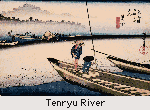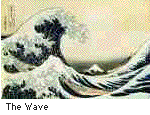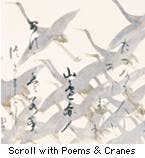|
Hiroshige 1797-1858 Japanese master painter of color prints, second in importance only to Hokusai.
Born in Yedo (today Tokyo) Hiroshige soon earned the name "artist with the sweeping brush" because of his ability to suggest vast landscapes in a few lines. Bare paper was as important to him as color in showing great snowfields, the sea, and the sky in his paintings. His most famous sets of prints include, Fifty-Three Stations of the Takaido Road, and The Hunder Views of Yedo.
www link :
Hokusai was born in Yedo (now Tokyo), and largely taught himself. His free brush drawings in watercolor were transferred to wood blocks by artisans in classical Japanese style. Then they were printed by hand. His Thirty-six Views of Fuji, Famous Bridges and Waterfalls and the famous Wave are considered the finest examples of Japanese drawings.
www link :
Hon-ami, likened to Leonardo da Vinci, was a multi-talented, irrepressible genius who inspired his contemporaries and exerted profound influence on generations to come. He collaborated with other outstanding artists of his day to breathe new life into traditional formats.
Hon-ami has the unique distinction of having works in two different mediums - lacquerwork
and ceramic - designated "National Treasures" by the Japanese government.
|


